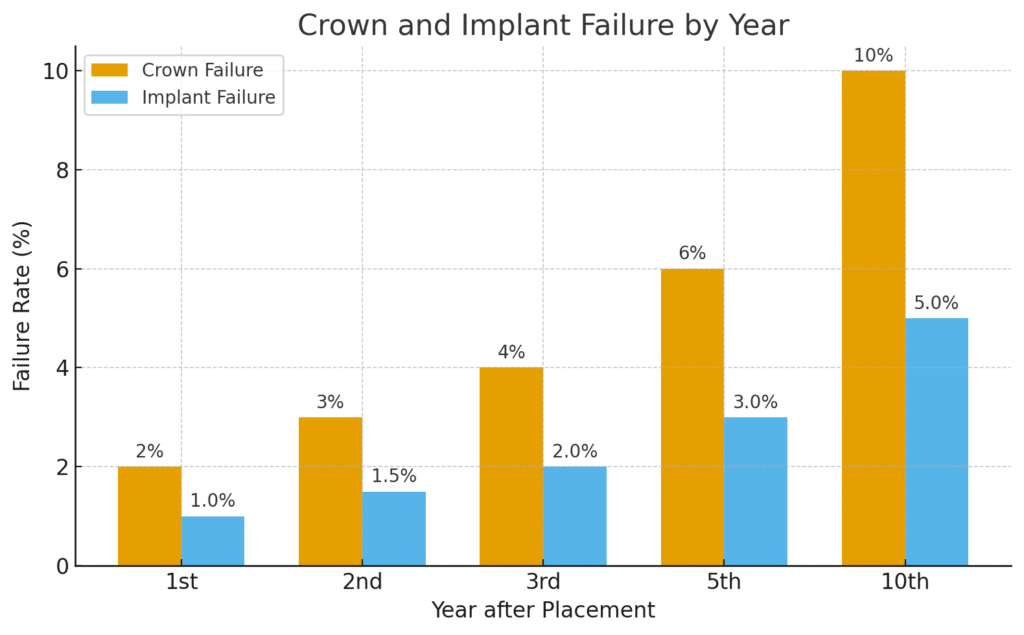A message from Dr. Edmond Ahdoot of Smiles by Eddie, serving Woodland Hills, Tarzana, and the greater San Fernando Valley.
Are you considering dental implants to restore your smile and improve your oral health? You’re not alone! Dental implants have revolutionized tooth replacement, offering a durable, natural-looking, and long-lasting solution for missing teeth. But with any significant dental procedure, it’s natural to have questions. This comprehensive guide will walk you through everything you need to know about dental implants, from the initial consultation to long-term care, helping you make an informed decision with confidence.
What Exactly Are Dental Implants?
At their core, dental implants are artificial tooth roots, typically made of titanium, that are surgically placed into your jawbone. These “roots” then fuse with your bone in a process called osseointegration, creating a strong and stable foundation for a replacement tooth (or teeth). Unlike dentures, which sit on the gums, implants are integrated into your bone, offering unparalleled stability and functionality. They can support crowns, bridges, or even full dentures, providing a solution that feels and functions remarkably like natural teeth.
Am I a Good Candidate for Dental Implants?
This is often the first question on everyone’s mind! The good news is that most people who are missing one or more teeth are good candidates for dental implants. However, certain factors are crucial for success:
- Good General Health: You should be healthy enough to undergo minor oral surgery.
- Sufficient Jawbone Density: There needs to be enough healthy bone to support the implant. If you’ve experienced bone loss, bone grafting procedures can often regenerate enough bone to make implants possible.
- Healthy Gums: Your gums should be free of periodontal disease.
- Commitment to Oral Hygiene: Maintaining excellent oral hygiene is vital for the long-term success of your implants.
- Non-Smoker or Willingness to Quit: Smoking can significantly hinder the healing process and increase the risk of implant failure.
During your initial consultation, your dentist will perform a thorough examination, including X-rays and possibly 3D scans, to assess your oral health and determine if implants are right for you.
The Dental Implant Process: What to Expect
The journey to a restored smile with dental implants typically involves several stages, spanning a few months. While it may seem like a lengthy process, each step is crucial for ensuring the long-term success and stability of your implant.
- Initial Consultation and Treatment Planning: This is where it all begins. Your dentist will examine your mouth, review your medical history, take detailed images (X-rays, CT scans), and discuss your treatment goals. A personalized treatment plan will be developed, outlining the number of implants, any necessary preparatory procedures (like bone grafting or tooth extractions), and the overall timeline.
- Tooth Extraction (If Necessary): If you have a damaged or decayed tooth that needs to be replaced by an implant, it will be extracted first. Sometimes, an implant can be placed immediately after extraction, but often a healing period is required.
- Bone Grafting (If Necessary): If your jawbone isn’t dense enough to support an implant, a bone graft will be performed. This procedure involves adding bone material to the jaw, which then integrates with your natural bone. This can take several months to heal before implant placement.
- Implant Placement Surgery: This is the core surgical step where the titanium implant post is precisely placed into your jawbone. This is typically done under local anesthesia, with sedation options available to ensure your comfort.
- Osseointegration (Healing Period): After the implant is placed, a critical healing period begins, usually lasting 3 to 6 months. During this time, the implant gradually fuses with your jawbone, creating a strong, stable foundation.
- Abutment Placement: Once osseointegration is complete, a small connector piece called an abutment is attached to the implant. This abutment will protrude through the gum line and serve as the anchor for your new crown. In some cases, the abutment can be placed at the same time as the implant.
- Crown Fabrication and Placement: Impressions of your mouth are taken to create a custom-made crown that perfectly matches the color, shape, and size of your natural teeth. Once fabricated, the crown is securely attached to the abutment, completing your new, fully functional tooth.
How Painful Is the Procedure and Recovery?
The thought of oral surgery can be daunting, but most patients are pleasantly surprised by how manageable the dental implant procedure and recovery are.
- During the Procedure: Local anesthesia is used to completely numb the area, so you should feel no pain during the implant placement. Many dentists also offer sedation options (like nitrous oxide or oral sedatives) to help you relax throughout the appointment.
- Post-Procedure: It’s normal to experience some mild discomfort, swelling, and bruising in the days following the surgery. This can usually be managed effectively with over-the-counter pain relievers or prescription medication if needed. Your dentist will provide detailed post-operative instructions to ensure a smooth recovery. Most patients report being back to their normal routine within a few days.
What Do Dental Implants Cost, and Will Insurance Cover It?
The cost of dental implants can vary widely depending on several factors, including:
- The number of implants needed
- The type of crown or restoration (single crown, bridge, denture)
- Any preparatory procedures (e.g., bone grafting, extractions)
- The complexity of the case
- The fees of your dentist and oral surgeon
Because dental implants are a significant investment, it’s essential to have a clear understanding of the costs involved. During your consultation, your dentist will provide a detailed breakdown of all expenses.
Regarding insurance, coverage for dental implants varies. Some dental insurance plans may cover a portion of the cost, especially if they are deemed medically necessary. However, many plans still consider them a cosmetic procedure or offer limited coverage. It’s crucial to check with your insurance provider directly and discuss financing options with your dental office, as many practices offer payment plans to make implants more affordable.
How Long Do Dental Implants Last?
One of the most appealing aspects of dental implants is their impressive longevity. With proper care, dental implants can last a lifetime. This makes them a highly cost-effective solution in the long run compared to other tooth replacement options that may require more frequent replacement or adjustments. The titanium post itself is designed to be a permanent fixture in your jawbone. While the crown attached to it may eventually need replacement (typically after 10-15 years, similar to a natural crown), the implant itself should remain intact.
What Are the Risks or Complications?
While dental implant surgery is generally very safe and highly successful, like any surgical procedure, there are potential risks, though they are rare. These can include:
- Infection at the implant site.
- Damage to surrounding structures, such as other teeth or blood vessels.
- Nerve damage, which can cause pain, numbness, or tingling in your natural teeth, gums, lips, or chin.
- Sinus problems, if implants in the upper jaw protrude into one of your sinus cavities.
- Implant failure, where the implant does not properly fuse with the bone. This is uncommon, with success rates typically over 95%.
Choosing an experienced and qualified dental professional significantly minimizes these risks.
Caring for Your Dental Implants
Caring for your dental implants is much like caring for your natural teeth. Excellent oral hygiene is paramount to ensure their longevity.
- Brush twice daily: Use a soft-bristled toothbrush and non-abrasive toothpaste.
- Floss daily: Special floss designed for implants or water flossers can be very effective in cleaning around the implant and crown.
- Regular Dental Check-ups: Continue to visit your dentist for routine check-ups and professional cleanings. Your dentist will monitor the health of your implants, gums, and overall oral health.
- Avoid hard or sticky foods: While implants are strong, it’s wise to avoid excessively hard candies or sticky foods that could potentially damage your crown.
Data and Quick Facts on Dental Implants
- High Success Rate: Dental implants boast a success rate of up to 98%, making them one of the most predictable procedures in dentistry.
- Widespread Use: Over 3 million Americans have dental implants, and that number continues to grow by over 500,000 each year.
- Longevity: While the implant post itself can last a lifetime, the crown or restoration on top typically lasts 10-15 years before needing replacement due to normal wear and tear.
Dental Implants vs. Other Common Treatments
| Feature | Dental Implants | Dental Bridges | Full/Partial Dentures |
| Durability | Permanent (implant post), Crown lasts 10-15 years | Typically 10-15 years | 5-10 years, often less |
| Bone Health | Prevents bone loss and stimulates growth | Does not prevent bone loss | Can accelerate bone loss |
| Impact on Other Teeth | No impact; neighboring teeth remain untouched | Requires grinding down adjacent healthy teeth | No impact on other teeth |
| Stability | Extremely secure; no slipping | Secure, but relies on neighboring teeth for support | Can slip, shift, or cause sore spots |
| Initial Cost | Higher upfront cost | Lower than implants | Lowest initial cost |
| Care & Maintenance | Same as natural teeth | Requires special tools for cleaning under the bridge | Must be removed for cleaning; may require adhesives |
Dental Implant Success Rates Over Time

The Last word
Dental implants offer a remarkable solution for restoring missing teeth, providing unmatched stability, aesthetics, and functionality. By understanding the process, what to expect, and how to care for them, you can embark on your journey to a fully restored, confident smile. If you’re considering dental implants, the best first step is always to schedule a consultation with a qualified dental professional who can assess your individual needs and guide you through every step of the process. Your perfect smile awaits!
Learn more from these trusted resources:
- American Dental Association (ADA) on Implants: https://www.mouthhealthy.org/all-topics-a-z/dental-implants
- Cleveland Clinic on Dental Implants: https://my.clevelandclinic.org/health/treatments/10903-dental-implants
Ready to find out if Dental Implants are right for you? Contact us to book an appointment today. You can also get to know our team by visiting our Meet Dr. Ahdoot page or see the transformations we’ve created in our gallery.

